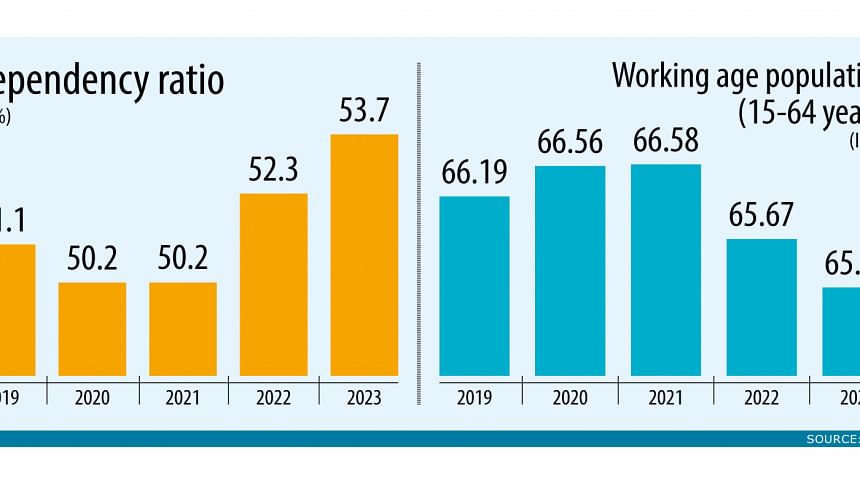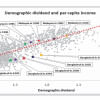Demographic dividend: How long can Bangladesh enjoy it?

Bangladesh is currently enjoying the benefits of the demographic dividend as the number of young people outnumbers the non-working-age population.
The demographic dividend is accelerated economic growth resulting from a country's declining mortality and fertility rates and subsequent changes in the age structure of the population.
Presently, the foremost question for Bangladesh is whether the current momentum will continue in the coming years as well or if it will soon lose momentum.
The question has arisen because the number of elderly people has increased over the years, pushing up the dependency ratio for the last two consecutive years.
The proportion of working-age people declined to 65.08 percent in 2023 from 66.58 percent in 2021, according to a survey of the Bangladesh Bureau of Statistics (BBS). A year before, the proportion was 65.67 percent.
Similarly, the dependency ratio of people who are over 65 rose to 9.4 percent last year from 8.6 percent in 2022.
The dependency ratio is a measure of the age structure of a population and also relates to the number of individuals likely to be economically "dependant" on the support of others.
In Bangladesh, there are two opinions among analysts and demographers about the dividend's beginning period. One group thinks it started in the 1990s while the other group says it arrived after 2000.
According to the government's Eighth Five-Year Plan, the share of the working-age population started to increase in 1978, heralding the beginning of the demographic window of opportunity.
Analysts and demographers warn Bangladesh's first demographic dividend window will close between 2033 and 2040.
"We are already in a declining stage as the dependency ratio is on the rise," said Mohammad Mainul Islam, a professor at the population sciences department at the University of Dhaka.
Rizwanul Islam, a former special adviser for the employment sector at the International Labour Organisation's office in Geneva, said as the ratio of people aged 60 to 64 years keeps rising, the opportunity to reap the demographic dividend exists.
The five-year plan envisages Bangladesh will become an ageing society by 2029 and an aged society by 2047.
The speed at which Bangladesh is likely to transition from an "ageing" society to the "aged" stage is faster than advanced Asian countries and rich European countries, according to the planning commission.
This is by far one of the fastest paces of ageing if compared with historical trends and data from France, the UK, Germany, and Sweden and other countries, it added.
Rizwanul Islam, however, says the proportion of the population in the age group of zero to four is still increasing. In about 11-15 years, they will enter the workforce.
"So, even if there is a bit of decline in some age groups, the proportion in the 15-64 group is not likely to fall substantially in the medium term. Hence, the potential for demographic dividend remains at least in the medium term."
The economist suggested making good use of the people belonging to the 60-65 age bracket.
"The implication for reviewing the retirement age is clear. There seems to be a good case for raising it to 65 years."
Getting a country's second demographic dividend depends on its maximum utilisation of the first dividend by investing much in human capital, education and health, said Prof Mainul Islam.
Some countries such as Japan, Germany, Singapore and Thailand have made the most of their second demographic dividend, he noted.
"Bangladesh's labour market is not like theirs. Owing to the emerging challenges stemming from Artificial Intelligence, it will be difficult to optimise the dividend."
The government's investment plan for education and health is taking too long to reap the demographic dividend, he added.
World Bank data showed Bangladesh is one of 20 developing countries with the largest populations of older adults—defined as 60 or older—in the world.
By 2025, Bangladesh, China, India, Indonesia, and Pakistan will account for about half of the world's older adult population.
"By 2025, one in 10 Bangladeshis will be 60 or older, and by 2050, that number will be one in five," it said.
Prof Mohammad Bellal Hossain, a professor of population sciences at the University of Dhaka, however, thinks that until the dependency ratio reaches 70 percent, it can't be said that the demographic dividend is fading.
"The demographic dividend is at its peak in Bangladesh."
Hossain, however, raised questions about the quality of the BBS's data on the dependency ratio and said there are procedural flaws.
For example, he argues, the dependency ratio and the child mortality rate have shown ups and downs over the years. "But the BBS does not explain it."
In response, Md Alamgir Hossen, project director of the survey, said, "There are no procedural flaws. The BBS is currently following the single-year reporting system and is gradually moving towards the modern system."

 For all latest news, follow The Daily Star's Google News channel.
For all latest news, follow The Daily Star's Google News channel. 











Comments